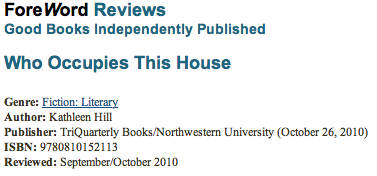[ Next review ]

Who Occupies This House is a haunting family saga that will sweep readers into a world of love, loss, and memory. At the death of her mother Kate, the narrator begins an investigative journey into the history of her family and the house they lived in for four generations. A narrative written in earnest, the narrator is desperate for details, clawing at what lies beneath the silence that surrounds her family's past. She re-creates her family history and offers a study of how silence and loss can create the opportunity for unbreakable familial bonds.
Though Hill delivers a lyrical novel that repeatedly gestures to the remnants of meaning left by poets of the past, she avoids the lofty tone of lyricism that can isolate readers. Instead, she delivers prose that burns with poetic brilliance and intensity. Her writing is electric and consuming. Reflecting on her desire to use her void of knowledge to "create characters out of…long-ago people," the narrator surmises that, "the silence is the shadow leaping on the wall." In this way she evokes raw emotion through fluid lines of prose that are saturated with double meanings.
Throughout this layered narrative, an unnamed provocateur presents probing questions to the narrator, urging her to analyze her motivations and reassess her conclusions, pricking at the fickle nature of memory. This voice offers a look into the layered meanings that thatch relationships together, but at times can seemed forced, the tone too much like an interview, lacking the seamless fluidity present in the rest of the book.
One of the most interesting aspects of this novel is Hill's creation of a living historical study. By embedding historic photographs and scans of diary entries into the text—the ink-blotted letters of old with spidery swoops of handwritten text—the reader is confronted with relics of the past, primary historical documents. This method creates a unique experience where readers are transformed into active participants, sifting through old journals and diaries along with the bereaved narrator, inspecting the slant of an ancestor's handwriting, reading into the upward curve of each individual letter; there is a physical bond between reader and text that becomes integral to the reading experience.
Readers who enjoy the layered history of Ondaatje's Running in the Family and other family sagas will find the intense interior study of family, love, and history in Who Occupies This House a welcome addition to their shelves.
—SHOILEE KAHN